Curcumin Acetylsalicylate Extends the Lifespan of Caenorhabditis elegans
Abstract
:1. Introduction
2. Materials and Methods
2.1. Chemicals and Materials
2.2. C. elegans Strains and Maintenance
2.3. Lifespan Assay
2.4. Stress Resistance and Heat Shock Assays
2.5. Lipofuscin Assay
2.6. Reproduction Assay
2.7. ROS Measurement
2.8. Nuclear Translocation of DAF-16
2.9. Visualization of SOD-3::GFP and GST-4::GFP
2.10. Quantitative Real-Time PCR
2.11. Statistical Analysis
3. Results
3.1. CA Promotes the Lifespan of C. elegans
3.2. CA Treatment Reduces Lipofuscin but Not Ovulation of C. elegans
3.3. CA Extends C. elegans Survival under Stress
3.4. CA Improves the Antioxidant Capacity of C. elegans
3.5. CA Upregulates SOD-3 Expression in C. elegans
3.6. CA Upregulates GST-4 Expression in C. elegans
3.7. CA Treatment Induces Nuclear Localization of DAF-16::GFP in the Presence of Oxidative Stress in C. elegans
3.8. Effects of CA on Aging-Related Gene Expression in C. elegans
3.9. The Roles of DAF-16 in the Regulation of C. elegans Lifespan
4. Discussion
Author Contributions
Funding
Institutional Review Board Statement
Informed Consent Statement
Data Availability Statement
Acknowledgments
Conflicts of Interest
References
- López-Otín, C.; Blasco, M.A.; Partridge, L.; Serrano, M.; Kroemer, G. The hallmarks of aging. Cell 2013, 153, 1194–1217. [Google Scholar] [CrossRef] [Green Version]
- Hodgson, R.; Kennedy, B.K.; Masliah, E.; Scearce-Levie, K.; Tate, B.; Venkateswaran, A.; Braithwaite, S.P. Aging: Therapeutics for a healthy future. Neurosci. Biobehav. Rev. 2020, 108, 453–458. [Google Scholar] [CrossRef] [PubMed]
- Phillips, T.; Leeuwenburgh, C. Lifelong aspirin supplementation as a means to extending life span. Rejuvenation Res. 2004, 7, 243–251. [Google Scholar] [CrossRef]
- Strong, R.; Miller, R.A.; Astle, C.M.; Floyd, R.A.; Flurkey, K.; Hensley, K.L.; Javors, M.A.; Leeuwenburgh, C.; Nelson, J.F.; Ongini, E.; et al. Nordihydroguaiaretic acid and aspirin increase lifespan of genetically heterogeneous male mice. Aging Cell. 2008, 7, 641–650. [Google Scholar] [CrossRef] [Green Version]
- Wan, Q.L.; Zheng, S.Q.; Wu, G.S.; Luo, H.R. Aspirin extends the lifespan of Caenorhabditis elegans via AMPK and DAF-16/FOXO in dietary restriction pathway. Exp. Gerontol. 2013, 48, 499–506. [Google Scholar] [CrossRef]
- Pietrocola, F.; Castoldi, F.; Maiuri, M.C.; Kroemer, G. Aspirin-another caloric-restriction mimetic. Autophagy 2018, 14, 1162–1163. [Google Scholar] [CrossRef] [PubMed]
- Pietrocola, F.; Castoldi, F.; Markaki, M.; Lachkar, S.; Chen, G.; Enot, D.P.; Durand, S.; Bossut, N.; Tong, M.; Malik, S.A.; et al. Aspirin recapitulates features of caloric restriction. Cell Rep. 2018, 22, 2395–2407. [Google Scholar] [CrossRef] [Green Version]
- De Berardis, G.; Lucisano, G.; D’Ettorre, A.; Pellegrini, F.; Lepore, V.; Tognoni, G.; Nicolucci, A. Association of aspirin use with major bleeding in patients with and without diabetes. JAMA 2012, 307, 2286–2294. [Google Scholar] [CrossRef] [Green Version]
- Nguyen, H.T.; Vu, T.Y.; Chandi, V.; Polimati, H.; Tatipamula, V.B. Dual COX and 5-LOX inhibition by clerodane diterpenes from seeds of Polyalthia longifolia (Sonn.) Thwaites. Sci. Rep. 2020, 10, 15965. [Google Scholar] [CrossRef]
- Huang, X.B.; Wu, G.S.; Ke, L.Y.; Zhou, X.G.; Wang, Y.H.; Luo, H.R. Aspirin derivative 5-(bis(3-methylbut-2-enyl)amino)-2-hydroxybenzoic acid improves thermotolerance via stress response proteins in Caenorhabditis elegans. Molecules 2018, 23. [Google Scholar] [CrossRef] [PubMed] [Green Version]
- Shamalnasab, M.; Gravel, S.P.; St-Pierre, J.; Breton, L.; Jäger, S.; Aguilaniu, H. A salicylic acid derivative extends the lifespan of Caenorhabditis elegans by activating autophagy and the mitochondrial unfolded protein response. Aging Cell 2018, 17, e12830. [Google Scholar] [CrossRef] [PubMed]
- Liao, V.H.; Yu, C.W.; Chu, Y.J.; Li, W.H.; Hsieh, Y.C.; Wang, T.T. Curcumin-mediated lifespan extension in Caenorhabditis elegans. Mech. Ageing Dev. 2011, 132, 480–487. [Google Scholar] [CrossRef] [PubMed]
- Shen, L.R.; Parnell, L.D.; Ordovas, J.M.; Lai, C.Q. Curcumin and aging. Biofactors 2013, 39, 133–140. [Google Scholar] [CrossRef] [PubMed]
- Akinyemi, A.J.; Oboh, G.; Ogunsuyi, O.; Abolaji, A.O.; Udofia, A. Curcumin-supplemented diets improve antioxidant enzymes and alter acetylcholinesterase genes expression level in Drosophila melanogaster model. Metab. Brain Dis. 2018, 33, 369–375. [Google Scholar] [CrossRef]
- Zia, A.; Farkhondeh, T.; Pourbagher-Shahri, A.M.; Samarghandian, S. The role of curcumin in aging and senescence: Molecular mechanisms. Biomed. Pharmacother. 2021, 134, 111119. [Google Scholar] [CrossRef]
- Stępień, K.; Wojdyła, D.; Nowak, K.; Mołoń, M. Impact of curcumin on replicative and chronological aging in the Saccharomyces cerevisiae yeast. Biogerontology 2020, 21, 109–123. [Google Scholar] [CrossRef] [Green Version]
- Heger, M. Drug screening: Don’t discount all curcumin trial data. Nature 2017, 543, 40. [Google Scholar] [CrossRef] [Green Version]
- Nelson, K.M.; Dahlin, J.L.; Bisson, J.; Graham, J.; Pauli, G.F.; Walters, M.A. The Essential medicinal chemistry of curcumin. J. Med. Chem. 2017, 60, 1620–1637. [Google Scholar] [CrossRef]
- Shu, B.; Xia, B.; Yan, D.; Guo, J.; Li, R. Synthesis of curcumin ester of aspirin. Chem. World 2014, 55, 169–171. [Google Scholar] [CrossRef]
- Frankowski, H.; Alavez, S.; Spilman, P.; Mark, K.A.; Nelson, J.D.; Mollahan, P.; Rao, R.V.; Chen, S.F.; Lithgow, G.J.; Ellerby, H.M. Dimethyl sulfoxide and dimethyl formamide increase lifespan of, C. elegans in liquid. Mech. Ageing Dev. 2013, 134, 69–78. [Google Scholar] [CrossRef]
- Stiernagle, T. Maintenance of C. elegans. WormBook 2006, 1551–8507. [Google Scholar] [CrossRef] [Green Version]
- Dilberger, B.; Baumanns, S.; Schmitt, F.; Schmiedl, T.; Hardt, M.; Wenzel, U.; Eckert, G.P. Mitochondrial Oxidative Stress Impairs Energy Metabolism and Reduces Stress Resistance and Longevity of, C. elegans. Oxid. Med. Cell. Longev. 2019, 2019, 6840540. [Google Scholar] [CrossRef] [Green Version]
- Bai, Z.; Wang, Y.; Zhang, R.; Xu, W.; Zhang, J. Studies on the retardation of senescence of Caenorhabditis elegans by essential Amino acids. Biol. Resour. 2017, 39, 175–180. [Google Scholar] [CrossRef]
- Yang, Z.Z.; Yu, Y.T.; Lin, H.R.; Liao, D.C.; Cui, X.H.; Wang, H.B. Lonicera japonica extends lifespan and healthspan in Caenorhabditis elegans. Free Radic. Biol. Med. 2018, 129, 310–322. [Google Scholar] [CrossRef] [PubMed]
- Song, B.; Zheng, B.; Li, T.; Liu, R.H. Raspberry extract promoted longevity and stress tolerance via the insulin/IGF signaling pathway and DAF-16 in Caenorhabditis elegans. Food Funct. 2020, 11, 3598–3609. [Google Scholar] [CrossRef]
- Hall, D.H.; Hartwieg, E.; Nguyen, K.C. Modern electron microscopy methods for, C. elegans. Methods Cell Biol. 2012, 107, 93–149. [Google Scholar] [CrossRef] [PubMed]
- Calculli, G.; Lee, H.J.; Shen, K.; Pham, U.; Herholz, M.; Trifunovic, A.; Dillin, A.; Vilchez, D. Systemic regulation of mitochondria by germline proteostasis prevents protein aggregation in the soma of, C. elegans. Sci. Adv. 2021, 7, eabg3012. [Google Scholar] [CrossRef] [PubMed]
- Yuan, Y.; Kang, N.; Li, Q.; Zhang, Y.; Liu, Y.; Tan, P. Study of the effect of neutral polysaccharides from Rehmannia glutinosa on lifespan of Caenorhabditis elegans. Molecules 2019, 24, 4592. [Google Scholar] [CrossRef] [Green Version]
- Wang, J.; Deng, N.; Wang, H.; Li, T.; Chen, L.; Zheng, B.; Liu, R.H. Effects of orange extracts on longevity, healthspan, and stress resistance in Caenorhabditis elegans. Molecules 2020, 25, 351. [Google Scholar] [CrossRef] [Green Version]
- Yoon, D.S.; Lee, M.H.; Cha, D.S. Measurement of Intracellular ROS in Caenorhabditis elegans Using 2’,7’-Dichlorodihydrofluorescein Diacetate. Bio-Protocol. 2018, 8. [Google Scholar] [CrossRef] [Green Version]
- Rangsinth, P.; Prasansuklab, A.; Duangjan, C.; Gu, X.; Meemon, K.; Wink, M.; Tencomnao, T. Leaf extract of Caesalpinia mimosoides enhances oxidative stress resistance and prolongs lifespan in Caenorhabditis elegans. BMC Complement Altern. Med. 2019, 19, 164. [Google Scholar] [CrossRef] [PubMed] [Green Version]
- Brunk, U.T.; Terman, A. Lipofuscin: Mechanisms of age-related accumulation and influence on cell function. Free Radic. Biol. Med. 2002, 33, 33–611. [Google Scholar] [CrossRef]
- Olsen, A.; Vantipalli, M.C.; Lithgow, G.J. Using Caenorhabditis elegans as a model for aging and age-related diseases. Ann. N Y Acad. Sci. 2006, 1067, 120–128. [Google Scholar] [CrossRef]
- Pomatto, L.; Davies, K. Adaptive homeostasis and the free radical theory of ageing. Free Radic. Biol. Med. 2018, 124, 420–430. [Google Scholar] [CrossRef]
- Hoogewijs, D.; Houthoofd, K.; Matthijssens, F.; Vandesompele, J.; Vanfleteren, J.R. Selection and validation of a set of reliable reference genes for quantitative sod gene expression analysis in, C. elegans. BMC Mol. Biol. 2008, 9, 9. [Google Scholar] [CrossRef] [PubMed] [Green Version]
- Fridovich, I. Superoxide radical and superoxide dismutases. Annu. Rev. Biochem. 1995, 64, 97–112. [Google Scholar] [CrossRef]
- Pohl, F.; Teixeira-Castro, A.; Costa, M.D.; Lindsay, V.; Fiuza-Fernandes, J.; Goua, M.; Bermano, G.; Russell, W.; Maciel, P.; Kong Thoo Lin, P. GST-4-Dependent Suppression of Neurodegeneration in C. elegans Models of Parkinson’s and Machado-Joseph Disease by Rapeseed Pomace Extract Supplementation. Front. Neurosci. 2019, 13, 1091. [Google Scholar] [CrossRef]
- Tullet, J.M.; Hertweck, M.; An, J.H.; Baker, J.; Hwang, J.Y.; Liu, S.; Oliveira, R.P.; Baumeister, R.; Blackwell, T.K. Direct inhibition of the longevity-promoting factor SKN-1 by insulin-like signaling in, C. elegans. Cell 2008, 132, 1025–1038. [Google Scholar] [CrossRef] [Green Version]
- Qi, W.; Huang, X.; Neumann-Haefelin, E.; Schulze, E.; Baumeister, R. Cell-nonautonomous signaling of FOXO/DAF-16 to the stem cells of Caenorhabditis elegans. PLoS Genet. 2012, 8, e1002836. [Google Scholar] [CrossRef] [Green Version]
- Murphy, C.T.; McCarroll, S.A.; Bargmann, C.I.; Fraser, A.; Kamath, R.S.; Ahringer, J.; Li, H.; Kenyon, C. Genes that act downstream of DAF-16 to influence the lifespan of Caenorhabditis elegans. Nature 2003, 424, 277–283. [Google Scholar] [CrossRef]
- Sampayo, J.N.; Olsen, A.; Lithgow, G.J. Oxidative stress in Caenorhabditis elegans: Protective effects of superoxide dismutase/catalase mimetics. Aging Cell. 2003, 2, 319–326. [Google Scholar] [CrossRef] [PubMed]
- Yan, Z.; Dai, Y.; Fu, H.; Zheng, Y.; Bao, D.; Yin, Y.; Chen, Q.; Nie, X.; Hao, Q.; Hou, D.; et al. Curcumin exerts a protective effect against premature ovarian failure in mice. J. Mol. Endocrinol. 2018, 60, 261–271. [Google Scholar] [CrossRef] [Green Version]
- Liu, Y.; Weng, W.; Gao, R.; Liu, Y. New Insights for Cellular and Molecular Mechanisms of Aging and Aging-Related Diseases: Herbal Medicine as Potential Therapeutic Approach. Oxid. Med. Cell. Longev. 2019, 2019, 4598167. [Google Scholar] [CrossRef] [PubMed] [Green Version]
- Ayyadevara, S.; Bharill, P.; Dandapat, A.; Hu, C.; Khaidakov, M.; Mitra, S.; Reis, R.J.S.; Mehta, J.L. Aspirin inhibits oxidant stress, reduces age-associated functional declines, and extends lifespan of Caenorhabditis elegans. Antioxid Redox Signal. 2013, 18, 481–490. [Google Scholar] [CrossRef]
- Huang, X.B.; Mu, X.H.; Wan, Q.L.; He, X.M.; Wu, G.S.; Luo, H.R. Aspirin increases metabolism through germline signalling to extend the lifespan of Caenorhabditis elegans. PLoS ONE 2017, 12, e0184027. [Google Scholar] [CrossRef] [Green Version]
- Hsin, H.; Kenyon, C. Signals from the reproductive system regulate the lifespan of C. elegans. Nature. 1999, 399, 362–366. [Google Scholar] [CrossRef]
- Yanju, W.; Jianwei, M.; Xizhuo, W.; Fang, Z.; Bailin, Z.; Laifa, W. Effect of grape seed procyanidins on anti-aging of Caenorhabditis elegans. Sci. Technol. Food Ind. 2014, 35, 369–73. [Google Scholar] [CrossRef]
- Snider, T.A.; Richardson, A.; Stoner, J.A.; Deepa, S.S. The geropathology grading platform demonstrates that mice null for Cu/Zn-superoxide dismutase show accelerated biological aging. Geroscience 2018, 40, 97–103. [Google Scholar] [CrossRef] [Green Version]
- Yamamoto, T.; Takabatake, Y.; Kimura, T.; Takahashi, A.; Namba, T.; Matsuda, J.; Minami, S.; Kaimori, J.-Y.; Matsui, I.; Kitamura, H.; et al. Time-dependent dysregulation of autophagy: Implications in aging and mitochondrial homeostasis in the kidney proximal tubule. Autophagy 2016, 12, 801–813. [Google Scholar] [CrossRef] [Green Version]
- Sanadhya, P.; Bucki, P.; Liarzi, O.; Ezra, D.; Gamliel, A.; Braun Miyara, S. Caenorhabditis elegans susceptibility to Daldinia cf. concentrica bioactive volatiles is coupled with expression activation of the stress-response transcription factor daf-16, a part of distinct nematicidal action. PLoS ONE 2018, 13, e0196870. [Google Scholar] [CrossRef]
- Dues, D.J.; Andrews, E.K.; Senchuk, M.M.; Van Raamsdonk, J.M. Resistance to stress can be experimentally dissociated from longevity. J. Gerontol. A Biol. Sci. Med. Sci. 2019, 74, 1206–1214. [Google Scholar] [CrossRef] [Green Version]
- Dehghan, E.; Zhang, Y.; Saremi, B.; Yadavali, S.; Hakimi, A.; Dehghani, M.; Goodarzi, M.; Tu, X.; Robertson, S.; Lin, R.; et al. Hydralazine induces stress resistance and extends C. elegans lifespan by activating the NRF2/SKN-1 signalling pathway. Nat. Commun. 2017, 2223. [Google Scholar] [CrossRef] [PubMed] [Green Version]
- Wang, C.; An, J.; Bai, Y.; Li, H.; Chen, H.; Ou, D.; Liu, Y. Tris(1,3-dichloro-2-propyl) phosphate accelerated the aging process induced by the 4-hydroxynon-2-enal response to reactive oxidative species in Caenorhabditis elegans. Environ. Pollut. 2019, 246, 904–913. [Google Scholar] [CrossRef]
- Pincus, Z.; Mazer, T.C.; Slack, F.J. Autofluorescence as a measure of senescence in C. elegans: Look to red, not blue or green. Aging 2016, 8, 889–998. [Google Scholar] [CrossRef] [PubMed] [Green Version]
- Lu, M.; Tan, L.; Zhou, X.G.; Yang, Z.L.; Zhu, Q.; Chen, J.N.; Luo, H.R.; Wu, G.S. Tectochrysin increases stress resistance and extends the lifespan of Caenorhabditis elegans via FOXO/DAF-16. Biogerontology 2020, 21, 669–682. [Google Scholar] [CrossRef] [PubMed]
- Lushchak, O.; Piskovatska, V.; Strilbytska, O.; Kindrat, I.; Stefanyshyn, N.; Koliada, A.; Bubalo, V.; Storey, K.B.; Vaiserman, A. Aspirin as a Potential Geroprotector: Experimental Data and Clinical Evidence. Adv. Exp. Med. Biol. 2021, 1286, 145–161. [Google Scholar] [CrossRef] [PubMed]
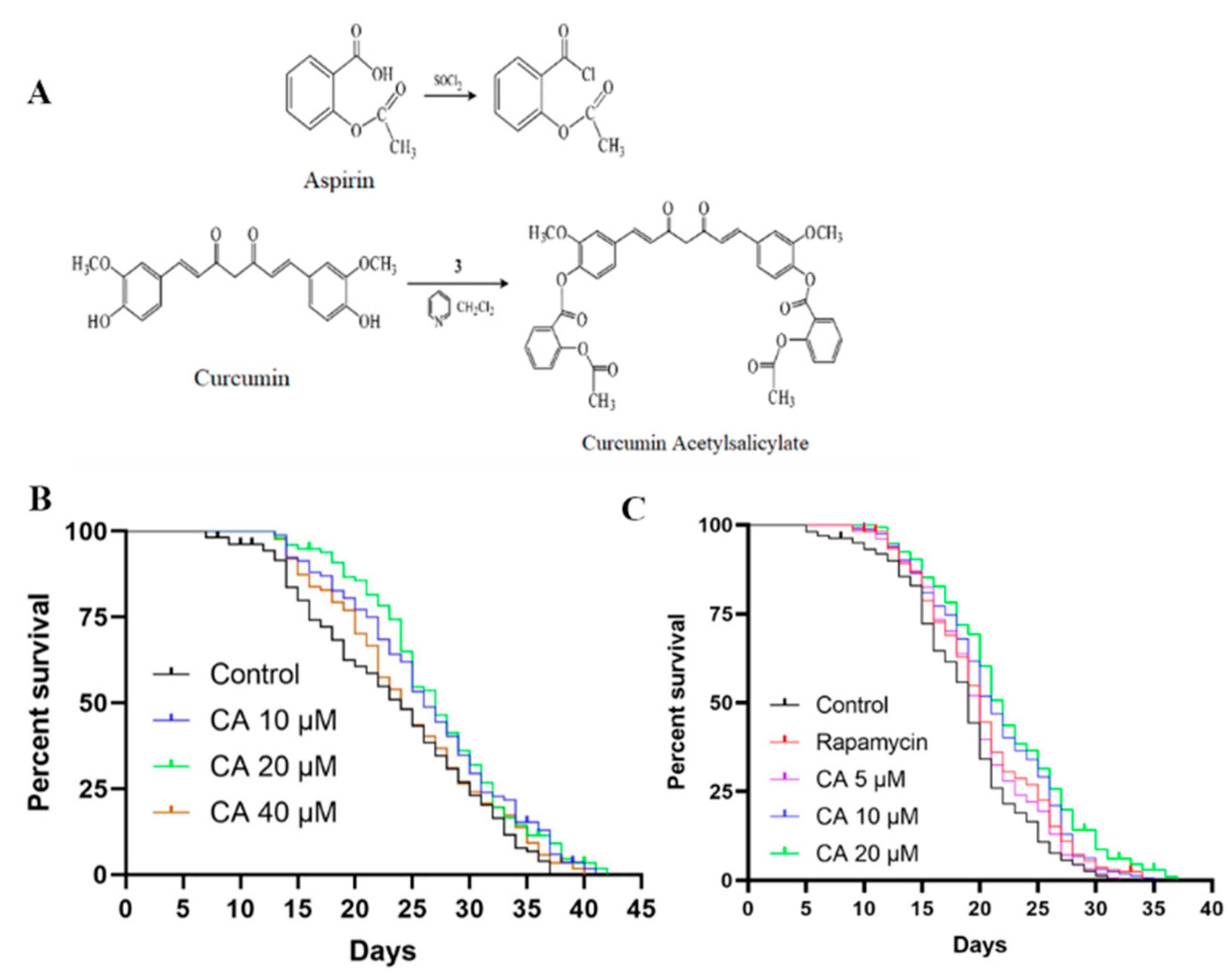
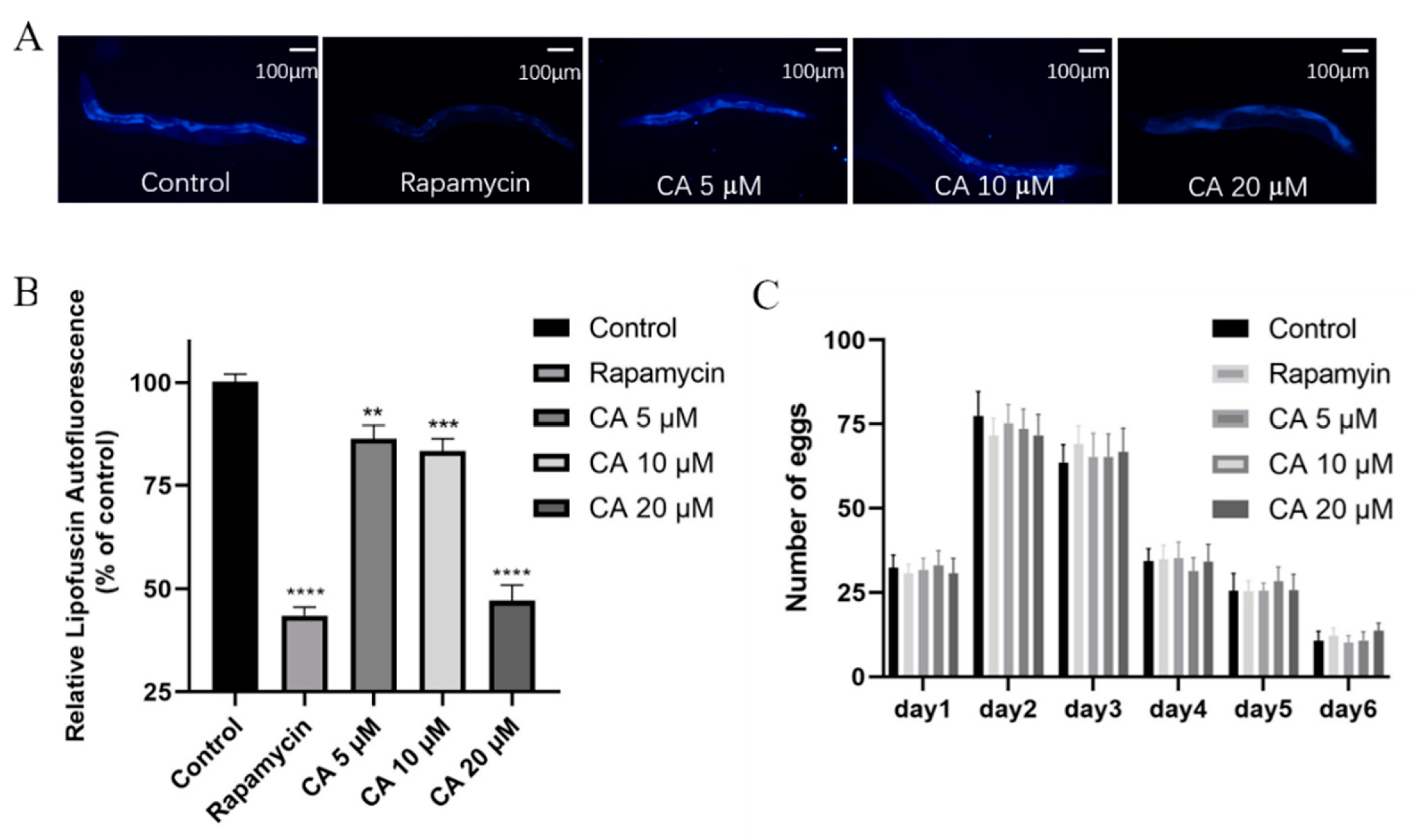
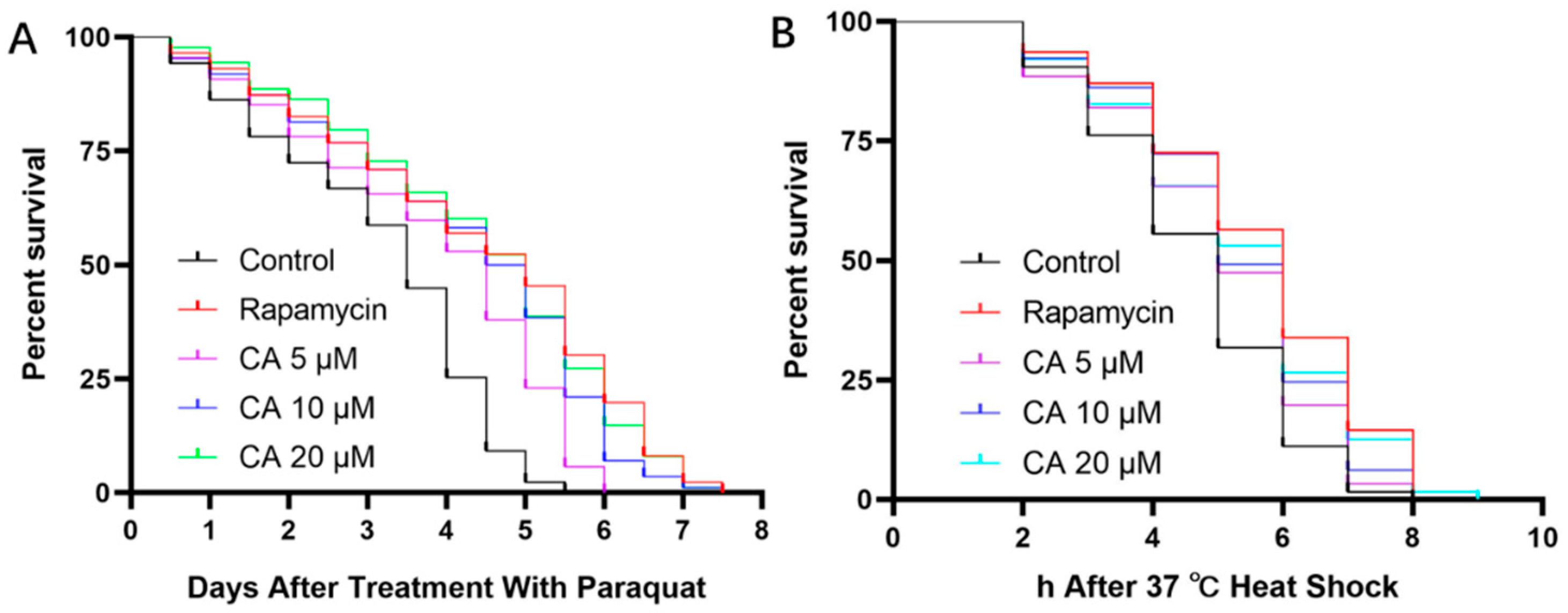

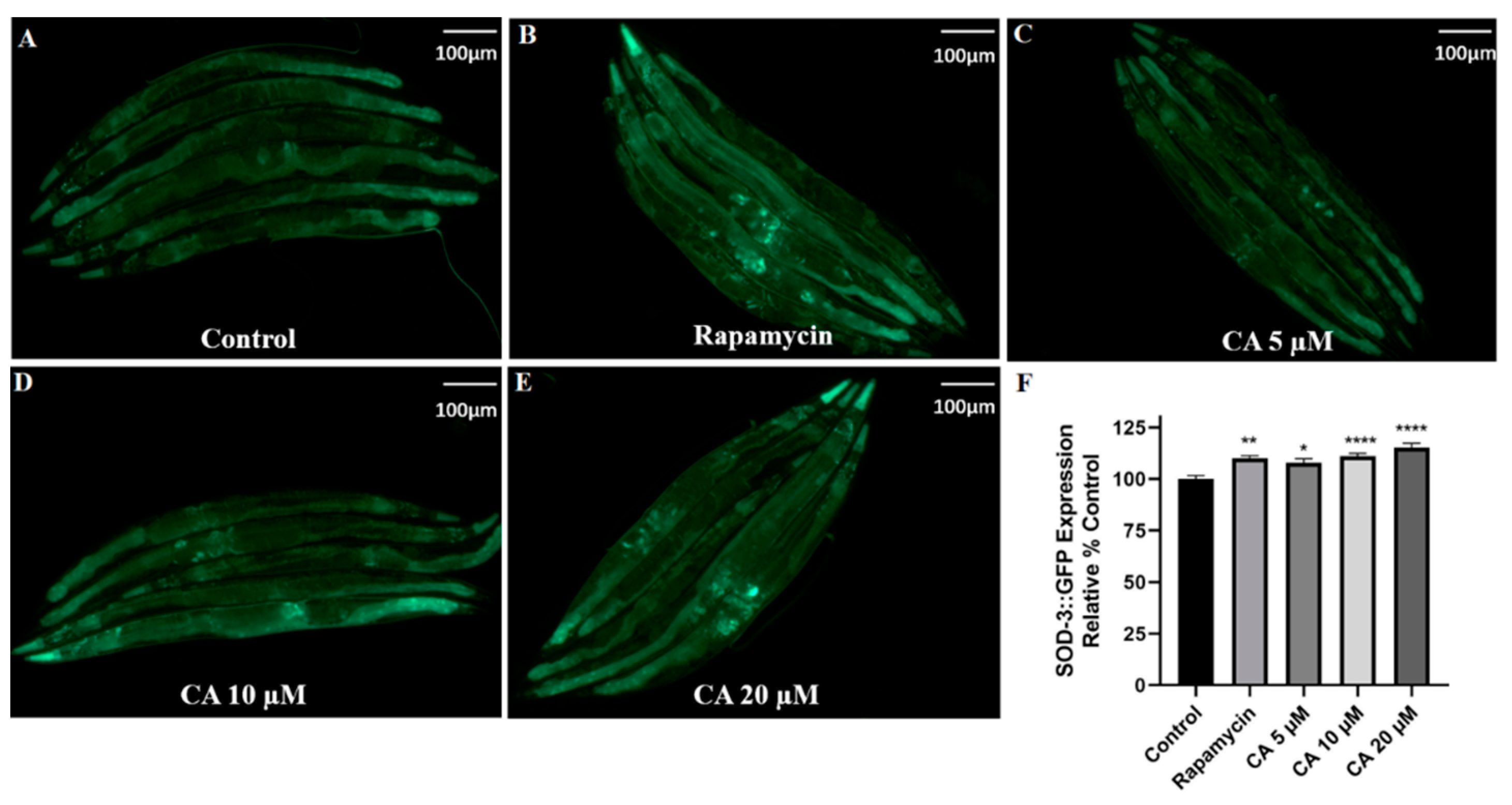
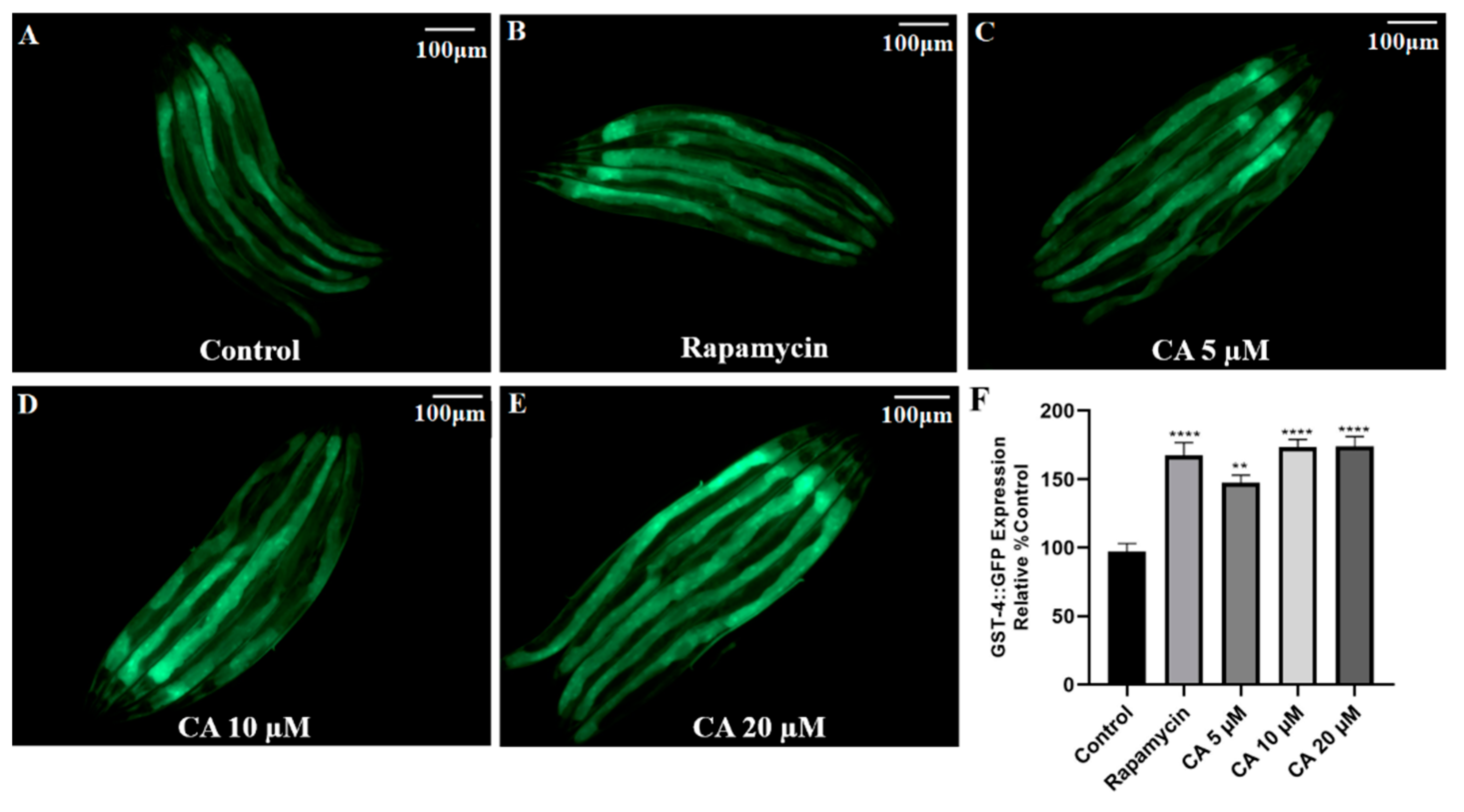
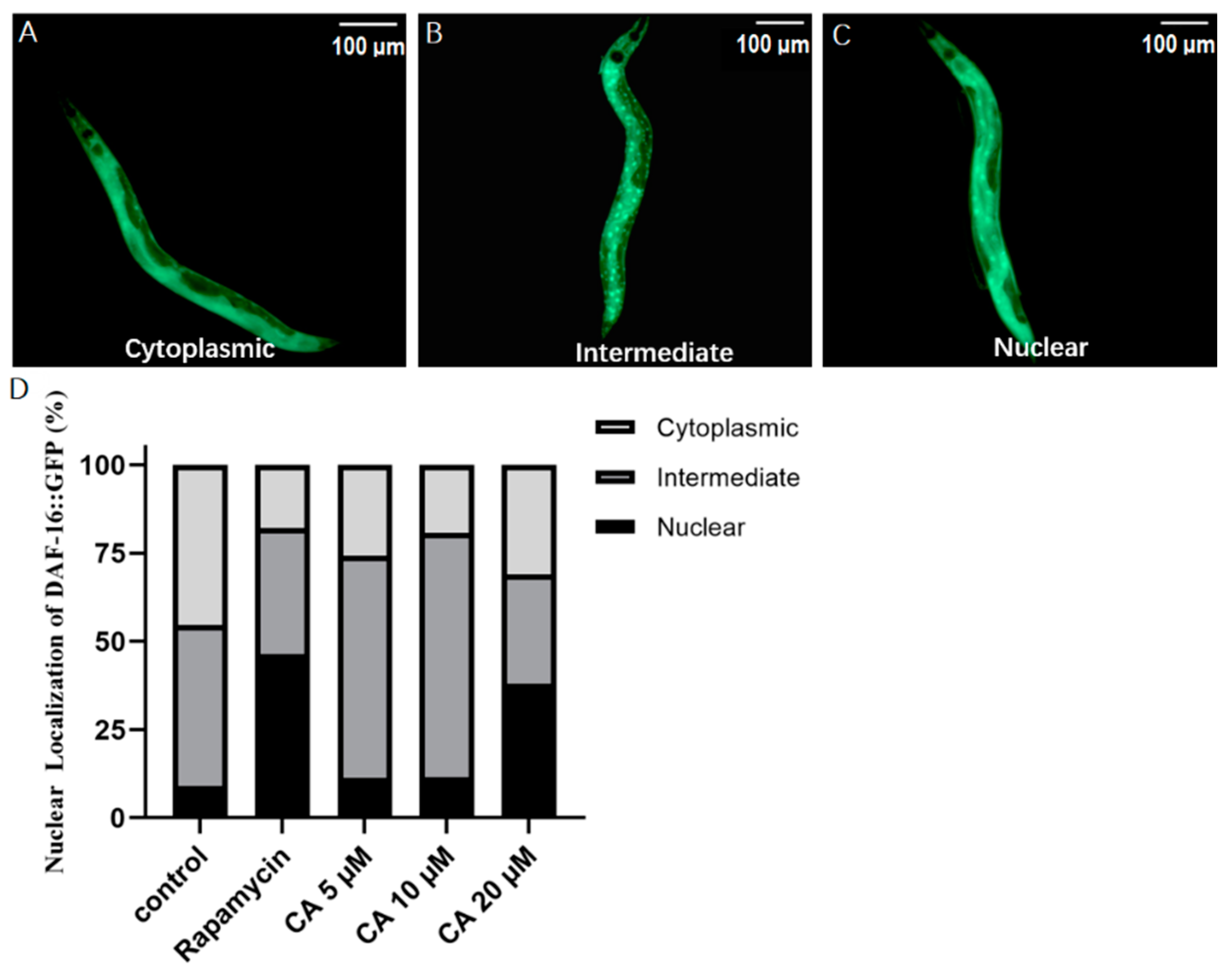
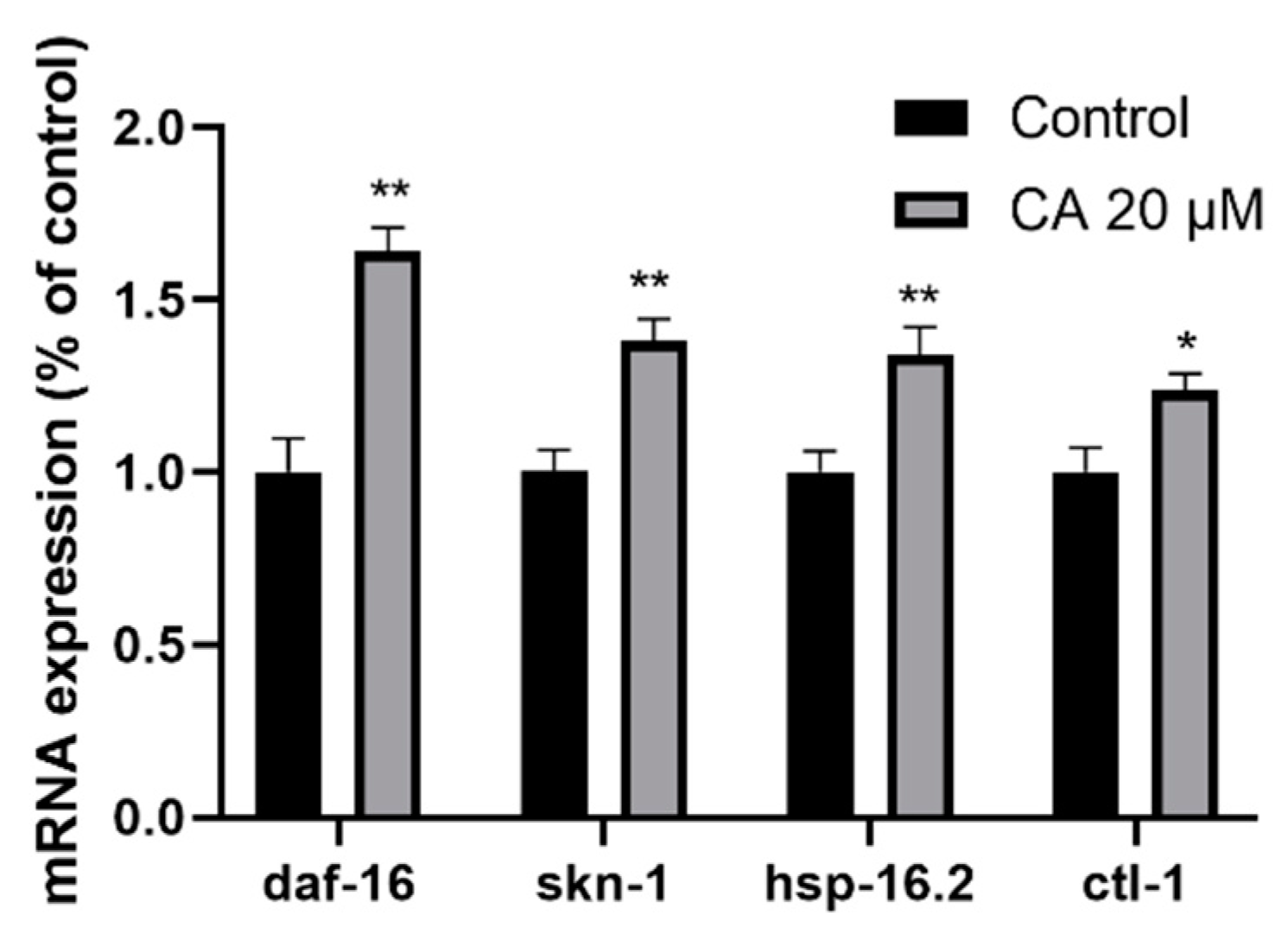

| Number of Worms | Mean Lifespan ± SE (Days) | % of Control | p Value | |
|---|---|---|---|---|
| Control | 161 | 24.36 ± 0.71 | 100.00 | / |
| CA 10 μM | 146 | 26.58 ± 0.71 | 109.11 | 0.032 |
| CA 20 μM | 174 | 27.05 ± 0.64 | 111.05 | 0.023 |
| CA 40 μM | 151 | 25.34 ± 0.72 | 104.02 | 0.380 |
| Number of Worms | Mean Lifespan ± SE (Days) | % of Control | p Value | |
|---|---|---|---|---|
| Control | 168 | 18.92 ± 0.42 | 100.00 | / |
| Rapamycin | 185 | 20.68 ± 0.42 | 109.30 | <0.05 |
| CA 5 μM | 178 | 20.77 ± 0.40 | 109.78 | <0.05 |
| CA 10 μM | 182 | 21.25 ± 0.41 | 112.32 | <0.05 |
| CA 20 μM | 165 | 22.33 ± 0.46 | 118.02 | <0.0001 |
| Number of Worms | Mean Lifespan ± SE (Days) | % of Control | p Value | |
|---|---|---|---|---|
| Control(paraquat) | 86 | 4.91 ± 0.24 | 100.00 | / |
| Rapamycin(paraquat) | 90 | 6.22 ± 0.28 | 126.68 | <0.001 |
| CA 5 μM(paraquat) | 90 | 5.34 ± 0.24 | 108.76 | ns |
| CA 10 μM(paraquat) | 90 | 5.82 ± 0.27 | 118.53 | <0.05 |
| CA 20 μM(paraquat) | 89 | 6.34 ± 0.27 | 129.12 | <0.0001 |
| Number of Worms | Mean Lifespan ± SE (Hours) | % of Control | p Value | |
|---|---|---|---|---|
| Control(37 °C) | 63 | 4.67 ± 0.19 | 100.00 | / |
| Rapamycin(37 °C) | 62 | 5.58 ± 0.22 | 119.49 | <0.05 |
| CA 5 μM(37 °C) | 62 | 5.09 ± 0.21 | 108.99 | ns |
| CA 10 μM(37 °C) | 65 | 5.31 ± 0.20 | 113.7- | ns |
| CA 20 μM(37 °C) | 66 | 5.43 ± 0.22 | 116.27 | <0.05 |
| Number of Worms | Mean Lifespan ± SE (Days) | % of Control | p Value | |
|---|---|---|---|---|
| Control | 216 | 15.35 ± 0.26 | 100.00 | / |
| CA 20 μM | 232 | 15.49 ± 0.23 | 100.91 | p = 0.9597 |
Publisher’s Note: MDPI stays neutral with regard to jurisdictional claims in published maps and institutional affiliations. |
© 2021 by the authors. Licensee MDPI, Basel, Switzerland. This article is an open access article distributed under the terms and conditions of the Creative Commons Attribution (CC BY) license (https://creativecommons.org/licenses/by/4.0/).
Share and Cite
Zhou, L.; Liu, J.; Bu, L.-L.; Liao, D.-F.; Cheng, S.-W.; Zheng, X.-L. Curcumin Acetylsalicylate Extends the Lifespan of Caenorhabditis elegans. Molecules 2021, 26, 6609. https://doi.org/10.3390/molecules26216609
Zhou L, Liu J, Bu L-L, Liao D-F, Cheng S-W, Zheng X-L. Curcumin Acetylsalicylate Extends the Lifespan of Caenorhabditis elegans. Molecules. 2021; 26(21):6609. https://doi.org/10.3390/molecules26216609
Chicago/Turabian StyleZhou, Lei, Jin Liu, Lan-Lan Bu, Duan-Fang Liao, Shao-Wu Cheng, and Xi-Long Zheng. 2021. "Curcumin Acetylsalicylate Extends the Lifespan of Caenorhabditis elegans" Molecules 26, no. 21: 6609. https://doi.org/10.3390/molecules26216609
APA StyleZhou, L., Liu, J., Bu, L.-L., Liao, D.-F., Cheng, S.-W., & Zheng, X.-L. (2021). Curcumin Acetylsalicylate Extends the Lifespan of Caenorhabditis elegans. Molecules, 26(21), 6609. https://doi.org/10.3390/molecules26216609






